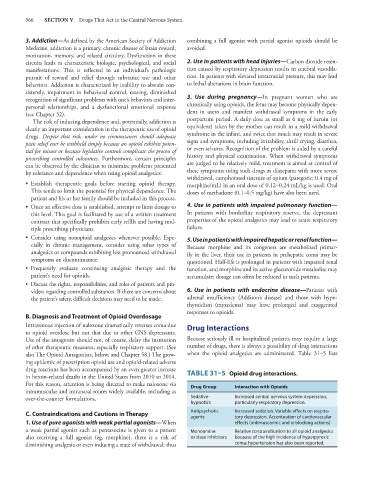Page 580 - Basic _ Clinical Pharmacology ( PDFDrive )
P. 580
566 SECTION V Drugs That Act in the Central Nervous System
3. Addiction—As defined by the American Society of Addiction combining a full agonist with partial agonist opioids should be
Medicine, addiction is a primary, chronic disease of brain reward, avoided.
motivation, memory, and related circuitry. Dysfunction in these
circuits leads to characteristic biologic, psychological, and social 2. Use in patients with head injuries—Carbon dioxide reten-
manifestations. This is reflected in an individual’s pathologic tion caused by respiratory depression results in cerebral vasodila-
pursuit of reward and relief through substance use and other tion. In patients with elevated intracranial pressure, this may lead
behaviors. Addiction is characterized by inability to abstain con- to lethal alterations in brain function.
sistently, impairment in behavioral control, craving, diminished
recognition of significant problems with one’s behaviors and inter- 3. Use during pregnancy—In pregnant women who are
personal relationships, and a dysfunctional emotional response chronically using opioids, the fetus may become physically depen-
(see Chapter 32). dent in utero and manifest withdrawal symptoms in the early
The risk of inducing dependence and, potentially, addiction is postpartum period. A daily dose as small as 6 mg of heroin (or
clearly an important consideration in the therapeutic use of opioid equivalent) taken by the mother can result in a mild withdrawal
drugs. Despite that risk, under no circumstances should adequate syndrome in the infant, and twice that much may result in severe
pain relief ever be withheld simply because an opioid exhibits poten- signs and symptoms, including irritability, shrill crying, diarrhea,
tial for misuse or because legislative controls complicate the process of or even seizures. Recognition of the problem is aided by a careful
prescribing controlled substances. Furthermore, certain principles history and physical examination. When withdrawal symptoms
can be observed by the clinician to minimize problems presented are judged to be relatively mild, treatment is aimed at control of
by tolerance and dependence when using opioid analgesics: these symptoms using such drugs as diazepam; with more severe
withdrawal, camphorated tincture of opium (paregoric; 0.4 mg of
• Establish therapeutic goals before starting opioid therapy. morphine/mL) in an oral dose of 0.12–0.24 mL/kg is used. Oral
This tends to limit the potential for physical dependence. The doses of methadone (0.1–0.5 mg/kg) have also been used.
patient and his or her family should be included in this process.
• Once an effective dose is established, attempt to limit dosage to 4. Use in patients with impaired pulmonary function—
this level. This goal is facilitated by use of a written treatment In patients with borderline respiratory reserve, the depressant
contract that specifically prohibits early refills and having mul- properties of the opioid analgesics may lead to acute respiratory
tiple prescribing physicians. failure.
• Consider using nonopioid analgesics whenever possible. Espe- 5. Use in patients with impaired hepatic or renal function—
cially in chronic management, consider using other types of Because morphine and its congeners are metabolized primar-
analgesics or compounds exhibiting less pronounced withdrawal ily in the liver, their use in patients in prehepatic coma may be
symptoms on discontinuance. questioned. Half-life is prolonged in patients with impaired renal
• Frequently evaluate continuing analgesic therapy and the function, and morphine and its active glucuronide metabolite may
patient’s need for opioids. accumulate; dosage can often be reduced in such patients.
• Discuss the rights, responsibilities, and roles of patients and pro-
viders regarding controlled substances. If there are concerns about 6. Use in patients with endocrine disease—Patients with
the patient’s safety, difficult decisions may need to be made. adrenal insufficiency (Addison’s disease) and those with hypo-
thyroidism (myxedema) may have prolonged and exaggerated
responses to opioids.
B. Diagnosis and Treatment of Opioid Overdosage
Intravenous injection of naloxone dramatically reverses coma due Drug Interactions
to opioid overdose but not that due to other CNS depressants.
Use of the antagonist should not, of course, delay the institution Because seriously ill or hospitalized patients may require a large
of other therapeutic measures, especially respiratory support. (See number of drugs, there is always a possibility of drug interactions
also The Opioid Antagonists, below, and Chapter 58.) The grow- when the opioid analgesics are administered. Table 31–5 lists
ing epidemic of prescription opioid use and opioid-related adverse
drug reactions has been accompanied by an even greater increase TABLE 31–5 Opioid drug interactions.
in heroin-related deaths in the United States from 2010 to 2014.
For this reason, attention is being directed to make naloxone via Drug Group Interaction with Opioids
intramuscular and intranasal routes widely available, including as
over-the-counter formulations. Sedative- Increased central nervous system depression,
hypnotics particularly respiratory depression.
C. Contraindications and Cautions in Therapy Antipsychotic Increased sedation. Variable effects on respira-
agents tory depression. Accentuation of cardiovascular
1. Use of pure agonists with weak partial agonists—When effects (antimuscarinic and α-blocking actions).
a weak partial agonist such as pentazocine is given to a patient Monoamine Relative contraindication to all opioid analgesics
also receiving a full agonist (eg, morphine), there is a risk of oxidase inhibitors because of the high incidence of hyperpyrexic
diminishing analgesia or even inducing a state of withdrawal; thus coma; hypertension has also been reported.

